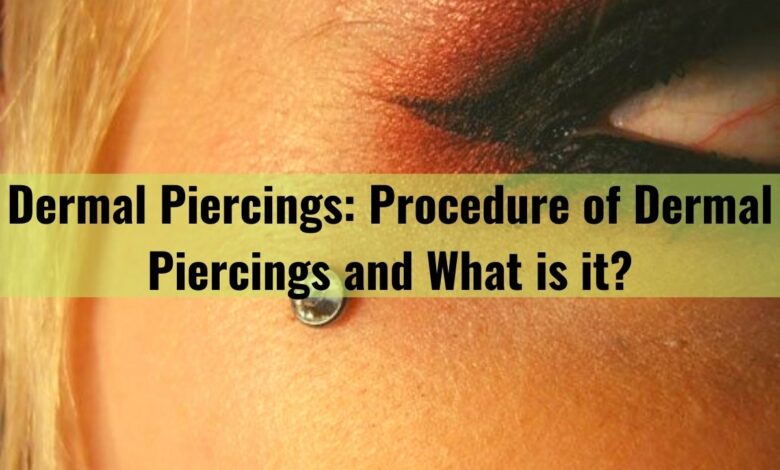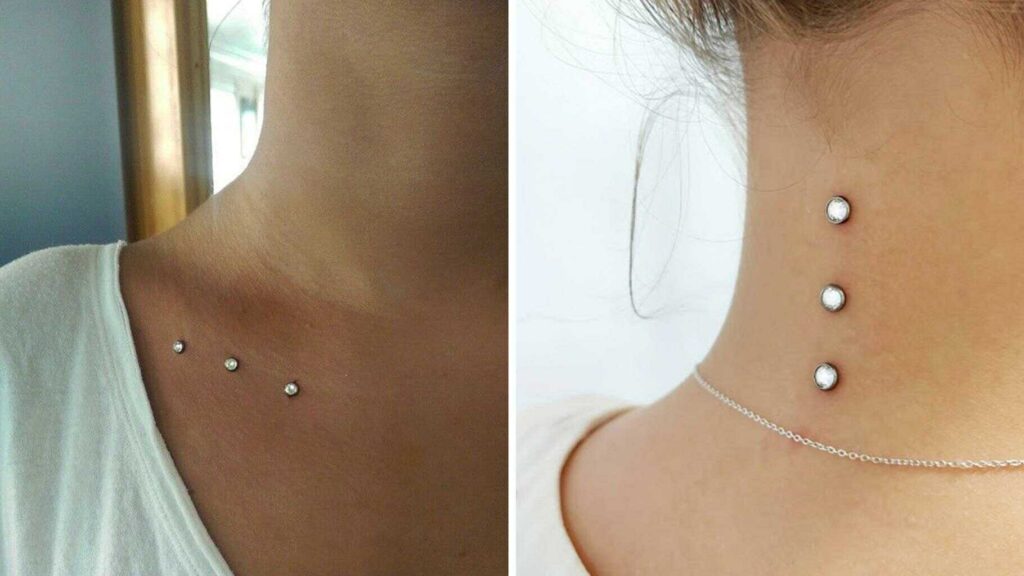Dermal Piercings: Procedure of Dermal Piercings and What is it?

Tattoos & piercings are becoming increasingly famous & addictive nowadays. As many superstars such as wrestlers, actors, & sportsmen put on these tattoos & piercings, they are role models for many other people & especially teenagers.
One such kind of new-generation piercing is dermal piercings. They are mainly located on the neck & the chest. In this article, we are going to identify what are dermal piercings, the procedure, the removal, & a lot more.
What Are Dermal Piercings?

Source: Cdn.onebauer.media
Dermal piercings, also known as single-point piercing, or micro-dermal piercing, are installed on a flat skin surface with a dermal anchor underneath the skin which holds the piercing in place.
Unlike other piercings, such as naval piercings, & earrings, dermal piercings only have an entry point as the jewelry rests on the surface that is secured with an anchor which is secured underneath the skin, hence there is no exit point created. The base of the anchor is mostly 6-7 millimeters long which is enough to secure the jewelry.
This option is pretty famous nowadays & is in trend because of the unlimited customizations possible with this kind of piercing. These piercings give a bead-like appearance which is gently put upon the skin.
Places Where a Dermal Piercing Can Be Installed
There are a few things to consider before installing a dermal piercing. Firstly, the area of the skin should be flat where the piercing is going to be placed. Secondly, the skin should be thick enough to hold the dermal anchor into place.
Some of the areas of the body where dermal piercings are mostly installed include cheekbones, chest, lower back, nape of the neck, thighs, nipples, & thighs.
How Much Does a Dermal Piercing Cost?
However, this hobby is not very cheap. One dermal piercing approximately costs between $70 & $100. This is the base amount & some places may charge you separately for the jewelry & you might even have to tip the piercer. There are also upfront costs involved related to aftercare which is advised by the experts.
Procedure for Dermal Piercings

Source: Byrdie.com
There is quite an interesting process for the installation of dermal piercings. It is done with either dermal punches or needles. The step-by-step process is described below.
- Firstly, the piercer will clean your skin properly with an antiseptic or any other liquid to make sure it is completely sterile.
- After the area gets completely dry, they will do a marking on your skin where the piercing has to be installed. This will be done using a pen or a marker.
- The piercer will now puncture your skin using a needle & will pull it back out creating an empty pocket for placing the anchor securely. Note that in this step, if the piercing procedure is done through dermal punches, then the puncture will be done using a punch. The skin punch will remove a tiny bit of skin tissue creating a pocket for the anchor to rest upon.
- After the hole is made, the piercer will use an instrument (usually forceps) to insert the base of the anchor into your skin. It will be inserted completely until the jewelry sits on the surface & the anchor is below it inside the skin.
- After the anchor is set, the jewelry will be screwed on top of the anchor.
Pain & Healing Time
No pain no gain they say. The same applies here, any kind of piercing will give you some amount of pain. Mainly, the piercing process acts as a deviating factor in pain.
The type of piecing matters most, dermal punches are considered less painful as compared to needle punctures. Also, the placement of the piercing matters too, the fleshier & flatter the skin, the less pain is inflicted.
It is best to conduct the piercing on the hands of a professional. The more professional the piercer is, the less time & pain it will take to successfully install the piercing. Along with that, an individual’s pain tolerance is also a determining factor as not everyone incurs the same amount of suffering.
A typical dermal piercing takes around 1-3 months to heal completely. At the initial stages, swelling & crusting around the area of piercing happens which is very routine.
Considerations & Complications
It’s always the best policy to follow your piercer’s instructions to avoid any complications. Dangers & complications include irregular scarring, skin infections, tissue damage, sharp pain, premature rejection, hyper granulation, & displacement.
Many of these complications occur when the piercing is done too deep into the skin. Always consult a doctor in case of problems.
Final Words
We hope that this article improved your knowledge substantially about dermal piercings & what dermal piercings are. Comment down below your views regarding it.




